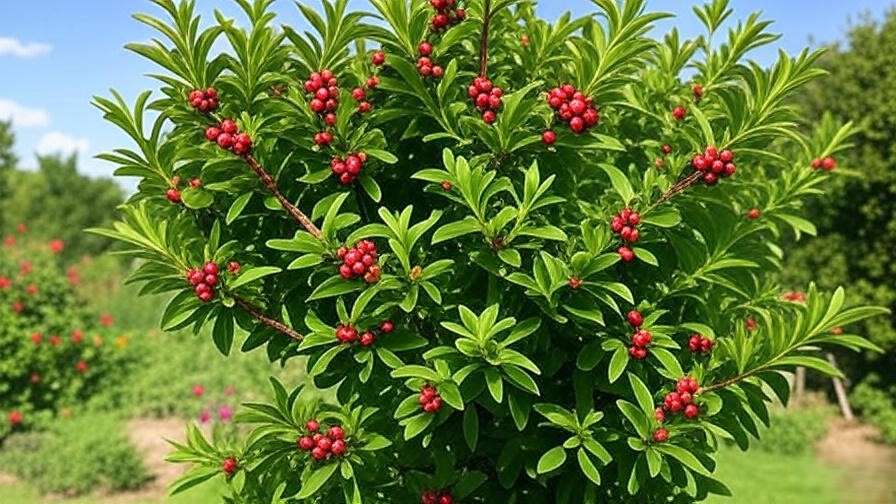Imagine stepping into your backyard to pick handfuls of sweet, juicy berries from your very own berries tree! 😋 Growing a berries tree not only brings fresh, nutrient-packed fruit to your table but also transforms your garden into a vibrant, eco-friendly oasis. Whether you’re a beginner or a seasoned gardener, this comprehensive guide will walk you through everything you need to know to plant, care for, and harvest from a thriving berries tree. From choosing the perfect variety to troubleshooting common issues, we’ve got you covered with expert-backed advice rooted in years of horticultural experience. 🌿 Let’s dive into the world of berries trees and unlock the secrets to vibrant yields! 🌞
Understanding Berries Trees: Types and Benefits 🌼
What Is a Berries Tree? 🌳
A berries tree is a fruit-bearing tree that produces edible berries, such as mulberries, elderberries, or serviceberries. Unlike berry bushes (think raspberries or blueberries), these trees grow taller, often reaching 20-50 feet, and offer both fruit and ornamental value. 🌸 Common varieties include the mulberry tree (Morus spp.), known for its sweet, dark berries, and the elderberry tree (Sambucus spp.), prized for its medicinal qualities. Serviceberries (Amelanchier spp.) are another favorite, offering delicate, apple-like fruits. Understanding the distinction between trees and shrubs is key to selecting the right plant for your garden’s space and climate. 🌿

Why Grow a Berries Tree? 🌟
Berries trees are a fantastic addition to any garden for several reasons:
- Health Benefits: Berries are packed with antioxidants, vitamins (like C and K), and fiber, supporting immunity and heart health. 🍎 For example, elderberries are renowned for their immune-boosting properties, often used in syrups.
- Environmental Perks: These trees attract pollinators like bees and butterflies, enhancing biodiversity. 🐝 Their deep roots also improve soil structure and prevent erosion.
- Economic Value: A single mature berries tree can yield pounds of fruit annually, saving you money on grocery bills. 💰
- Aesthetic Appeal: With lush foliage and colorful berries, these trees add beauty and shade to landscapes. 🎨
Choosing the Right Berries Tree for Your Garden 🪴
Factors to Consider Before Planting 📝
Selecting the right berries tree requires careful planning to ensure long-term success. Here are key factors to consider:
- Climate and Hardiness Zones: Most berries trees thrive in USDA zones 4-9. Mulberries, for instance, tolerate a wide range of climates, while elderberries prefer cooler regions. ☀️ Check your zone at USDA Plant Hardiness Zone Map for guidance.
- Space Requirements: Consider mature tree size. Mulberries can spread 30-50 feet, while serviceberries are more compact, ideal for smaller yards. 🌳
- Soil and Sunlight: Berries trees prefer well-drained, loamy soil with a pH of 5.5-7.0 and at least 6 hours of direct sunlight daily. 🌱
- Pollination: Some varieties, like certain mulberries, are self-pollinating, while others may need a companion tree for cross-pollination. 🐝
Top Berries Tree Varieties for Home Gardens 🌿
Here are three popular berries trees for home gardeners, each with unique traits:
- Mulberry (Morus spp.): Fast-growing with sweet, juicy berries. Varieties like Morus alba ‘Kingan’ are drought-tolerant and prolific. 🍇
- Elderberry (Sambucus spp.): Produces dark, tart berries perfect for jams and syrups. Sambucus nigra is a top choice for medicinal use. 🌸
- Serviceberry (Amelanchier spp.): Offers sweet, blueberry-like fruit and stunning spring blossoms. Amelanchier alnifolia is ideal for small spaces. 🍒
Table: Comparison of Berries Trees
| Variety | Mature Height | Fruit Yield | Care Level | Best For |
|---|---|---|---|---|
| Mulberry | 30-50 ft | High | Moderate | Large yards, jams |
| Elderberry | 10-20 ft | Moderate | Easy | Syrups, small spaces |
| Serviceberry | 15-25 ft | Moderate | Easy | Ornamental, fresh eating |
Planting Your Berries Tree: Step-by-Step Guide 🌱
When and Where to Plant 📅
Timing and location are critical for a healthy berries tree. Plant in early spring or fall when temperatures are mild, allowing roots to establish before extreme heat or cold. 🍂 Choose a site with full sun, well-drained soil, and protection from strong winds. Test your soil’s pH (aim for 5.5-7.0) using a home testing kit or consult your local extension service. 🧪 A sunny, open spot with good airflow minimizes disease risks and maximizes fruit production. 🌞
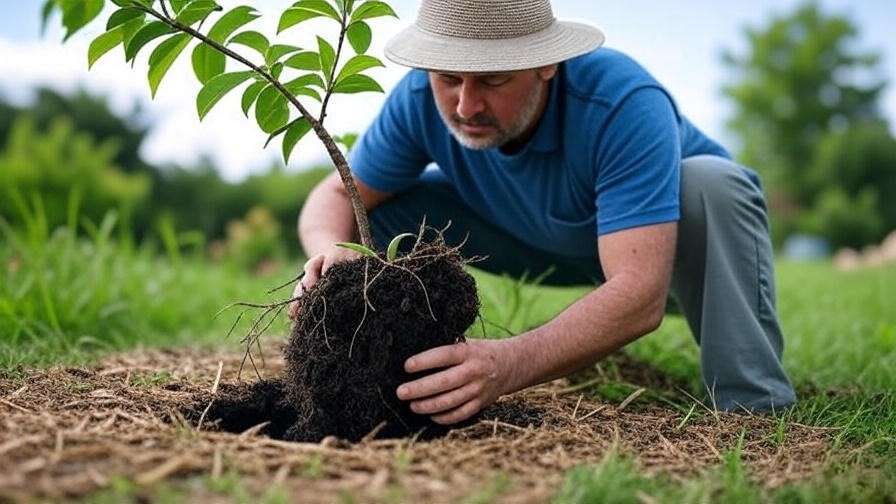
How to Plant a Berries Tree 🌳
Follow these steps for successful planting:
- Prepare the Hole: Dig a hole twice as wide and as deep as the root ball (e.g., 2 ft wide for a 1 ft root ball). ⛏️
- Amend the Soil: Mix native soil with compost or aged manure to boost nutrients and drainage. 🍄
- Position the Tree: Place the tree so the root collar (where roots meet trunk) sits level with the ground. 🌱
- Backfill and Water: Fill the hole, tamping soil gently to remove air pockets, then water deeply (1-2 gallons). 💧
- Mulch: Apply a 2-3 inch layer of organic mulch (e.g., wood chips) around the base, keeping it 2 inches from the trunk. 🌾
Common Mistakes to Avoid: Don’t plant too deep, as this can suffocate roots, or overwater, which may cause root rot. 🚫
Caring for Your Berries Tree: Essential Maintenance Tips 🌿
Watering and Irrigation 💦
Proper watering is crucial, especially in the first year. Young berries trees need 1-2 inches of water weekly, ideally through deep, infrequent sessions to encourage strong roots. 🌧️ Mature trees are more drought-tolerant but benefit from occasional deep watering during dry spells. A drip irrigation system is ideal, delivering water directly to the root zone while conserving resources. 🚿 Expert Tip: Check soil moisture by digging 2-3 inches down; water only if it feels dry.
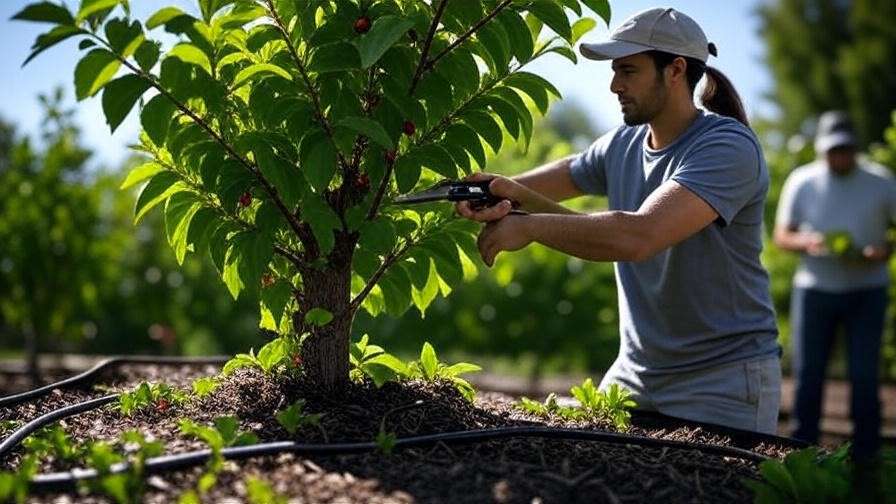
Fertilizing for Healthy Growth 🌾
Fertilize your berries tree to promote vigorous growth and fruit production. Apply a balanced fertilizer (e.g., 10-10-10) or organic compost in early spring, just before new growth begins. 📅 A second, lighter application in mid-summer can boost fruiting. Avoid over-fertilizing, as excess nitrogen leads to lush foliage but fewer berries. ⚠️ Expert Insight: Conduct a soil test every 2-3 years to tailor nutrient applications, available through local cooperative extensions.
Pruning and Shaping Your Berries Tree ✂️
Pruning enhances fruit yield and tree health. Prune in late winter or early spring before buds swell, using clean, sharp tools. ❄️ Focus on:
- Removing Dead Wood: Cut away damaged or diseased branches to prevent pest entry. 🌳
- Thinning: Remove crowded branches to improve airflow and light penetration, reducing disease risk. 🌬️
- Shaping: Maintain an open canopy for mulberries or a rounded shape for serviceberries. 🌿
Example: Pruning a Mulberry Tree
- Identify and remove dead or crossing branches.
- Thin the canopy by cutting 1-2 inner branches to allow sunlight to reach lower fruiting zones.
- Shorten overly long branches to maintain a manageable size. 📋
Mulching and Soil Care 🍄
Mulching conserves moisture, suppresses weeds, and regulates soil temperature. Apply a 2-3 inch layer of organic mulch like wood chips or straw annually, keeping it away from the trunk to prevent rot. 🌾 Refresh mulch in spring to maintain its benefits. Expert Tip: Use composted mulch to slowly release nutrients into the soil, enhancing long-term tree health.
Protecting Your Berries Tree from Pests and Diseases 🐞
Common Pests to Watch For 🕷️
Berries trees, while resilient, can attract pests that threaten fruit production and tree health. Here are the most common culprits and how to manage them:
- Aphids: These tiny insects suck sap from leaves, causing curling and stunted growth. 🐜 Solution: Introduce natural predators like ladybugs or spray with neem oil diluted in water (1 tsp per quart).
- Scale Insects: Small, immobile pests that form hard shells on branches, weakening the tree. 🐞 Solution: Apply horticultural oil in early spring to suffocate scales.
- Birds: Birds love juicy berries, especially mulberries. 🐦 Solution: Use bird netting or reflective tape to deter them without harming wildlife.
Prevention Tips: Maintain tree vigor through proper watering and fertilization, as healthy trees resist pests better. Regularly inspect leaves and branches for early signs of infestation. 🌿 Expert Insight: Companion planting with pest-repelling plants like marigolds can reduce aphid issues naturally. 🌸
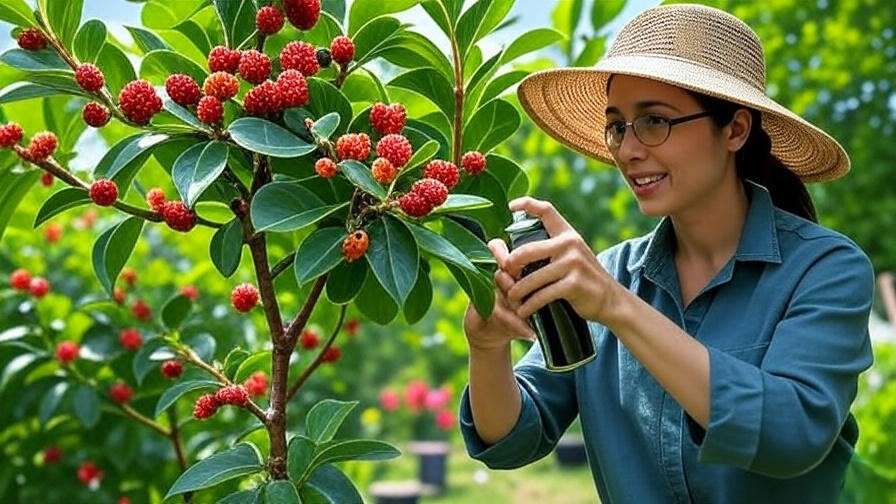
Diseases and How to Manage Them 🦠
Berries trees can face fungal and bacterial diseases, especially in humid conditions. Common issues include:
- Powdery Mildew: A white, powdery coating on leaves, often due to poor airflow. 🍂 Solution: Improve pruning to enhance circulation and apply a sulfur-based fungicide if needed.
- Root Rot: Caused by overwatering or poorly drained soil, leading to wilting and yellowing. 🚫 Solution: Ensure proper drainage and avoid overwatering; remove affected roots if caught early.
- Leaf Spot: Small, dark spots on leaves that may cause defoliation. 🌱 Solution: Remove and destroy affected leaves, and apply a copper-based fungicide.
Prevention: Space trees adequately (10-20 feet apart, depending on variety) to promote airflow, and avoid overhead watering to keep foliage dry. 🌬️ Table: Pest and Disease Guide
| Issue | Symptoms | Prevention | Treatment |
|---|---|---|---|
| Aphids | Curling leaves, sticky residue | Ladybugs, neem oil | Insecticidal soap |
| Powdery Mildew | White coating on leaves | Good airflow, proper pruning | Sulfur fungicide |
| Root Rot | Wilting, yellowing leaves | Well-drained soil, moderate water | Remove affected roots, improve drainage |
Harvesting and Enjoying Your Berries 🍓
When and How to Harvest 📅
Timing is everything when harvesting berries from your tree. Look for these signs of ripeness:
- Mulberries: Deep purple or black, soft to the touch, and easily detachable. 🍇
- Elderberries: Dark purple clusters that droop when ripe, typically late summer. 🌸
- Serviceberries: Red to purple, slightly soft, and sweet, usually early summer. 🍒
Harvesting Technique: Gently hand-pick berries to avoid bruising or damaging branches. Use a clean container to collect fruit, and harvest in the morning when berries are cool and flavorful. 😋 Expert Tip: Lay a clean tarp under mulberry trees to catch falling fruit, making collection easier and cleaner.

Uses for Your Berries Harvest 🍰
Your berries tree offers endless culinary possibilities! Here are some ideas:
- Fresh Eating: Enjoy mulberries or serviceberries straight from the tree for a sweet, healthy snack. 🍎
- Jams and Preserves: Cook elderberries or mulberries with sugar and pectin for homemade jams. 🫙
- Smoothies and Desserts: Blend berries into smoothies or bake them into pies and muffins. 🥧
- Medicinal Uses: Elderberries shine in syrups or teas, known for boosting immunity. 🌿
Preservation: Freeze berries in a single layer on a tray before transferring to airtight bags for up to a year. Alternatively, dry them in a dehydrator or can them as preserves. Recipe Idea: Elderberry Syrup
- Boil 1 cup elderberries with 2 cups water, 1 cup honey, and a pinch of ginger.
- Simmer for 30 minutes, strain, and store in a glass jar. Use 1 tsp daily for immune support. 😊
Troubleshooting Common Berries Tree Problems 🛠️
Why Isn’t My Berries Tree Producing Fruit? 🤔
A lack of fruit can be frustrating, but several factors could be at play:
- Insufficient Pollination: Some trees, like certain elderberries, need a second tree for cross-pollination. 🐝 Solution: Plant a compatible variety nearby or consult a nursery for self-pollinating options.
- Poor Pruning: Over-pruning or pruning at the wrong time can reduce fruiting buds. ✂️ Solution: Follow seasonal pruning guidelines (late winter) and avoid heavy cuts.
- Nutrient Deficiencies: Low potassium or phosphorus can limit fruit production. 🌾 Solution: Test soil and apply a balanced fertilizer as needed.
Addressing Growth Issues 🌱
- Stunted Growth: Compacted soil or root-bound trees (common in container-grown purchases) can restrict growth. 🚫 Solution: Loosen soil around the root zone or repot container trees into larger pots.
- Yellowing Leaves: Often a sign of overwatering, poor drainage, or nitrogen deficiency. 🍂 Solution: Adjust watering habits and test soil for nutrient levels.
- Expert Insight: Regular soil tests (every 2-3 years) through your local extension service can pinpoint issues before they affect fruit yield. 📊
FAQs About Growing Berries Trees ❓
- How long does it take for a berries tree to bear fruit? ⏳ Most berries trees, like mulberries, produce fruit within 2-5 years, depending on variety and care. Serviceberries may fruit in 1-3 years.
- Can berries trees grow in containers? 🪴 Yes, compact varieties like dwarf mulberries or serviceberries thrive in large pots (15-20 gallons) with good drainage.
- What’s the best way to protect berries from birds? 🐦 Use bird netting or hang reflective tape to deter birds without harming them.
- Are berries trees safe for pets and children? 🐶 Most berries, like mulberries and serviceberries, are safe, but elderberries must be cooked before consumption to avoid toxicity.
- How do I overwinter my berries tree in cold climates? ❄️ Mulch heavily around the base, wrap young trees in burlap, and avoid late-season fertilization to harden them off.
Expert Tips for Long-Term Success 🌟
- Companion Planting: Pair your berries tree with pollinator-friendly plants like lavender, borage, or clover to attract bees and boost fruit set. 🌸
- Seasonal Care Checklist:
- Spring: Fertilize, prune, and check for pests. 🌱
- Summer: Water deeply, monitor for diseases, and harvest. 💦
- Fall: Mulch and prepare for dormancy. 🍂
- Winter: Protect young trees from frost and prune lightly. ❄️
- Sustainable Practices: Use rainwater collection for irrigation and compost kitchen scraps for organic fertilizer. 🌍
- Case Study: Jane, a home gardener in Zone 6, planted a mulberry tree in 2020. By 2023, with consistent pruning and organic care, she harvested 10 pounds of fruit annually, turning it into jams and smoothies for her family. 🌳
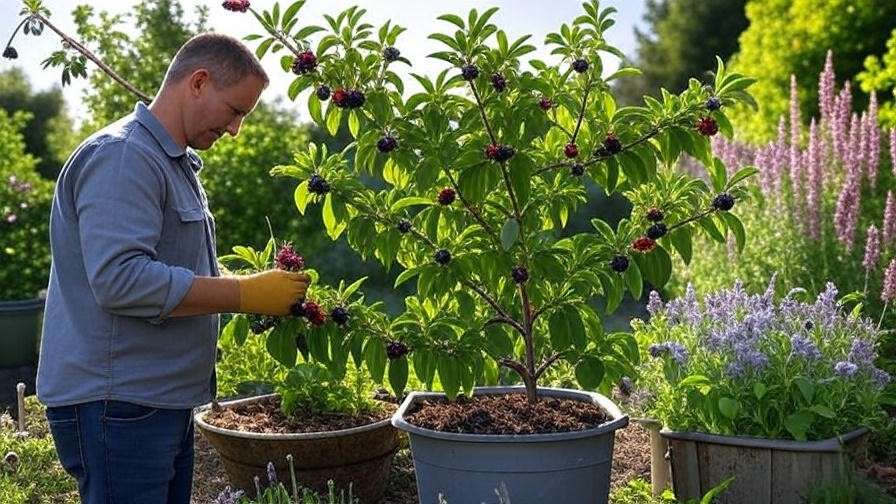
Conclusion: Grow Your Own Berries Tree with Confidence! 🌿
Growing a berries tree is a rewarding journey that brings fresh, delicious fruit and natural beauty to your garden. 🍇 By choosing the right variety, planting with care, and following expert maintenance tips, you can enjoy vibrant yields for years to come. From the sweet, juicy mulberries to the immune-boosting elderberries, your berries tree will be a source of pride and nourishment. 😋 Start small, experiment with the techniques in this guide, and don’t be afraid to learn as you grow! Share your berries tree journey in the comments or explore more plant care guides on our site to keep your garden thriving. 📝 With dedication and a little love, your berries tree will flourish, providing fruit, shade, and joy for seasons to come. 🌳

